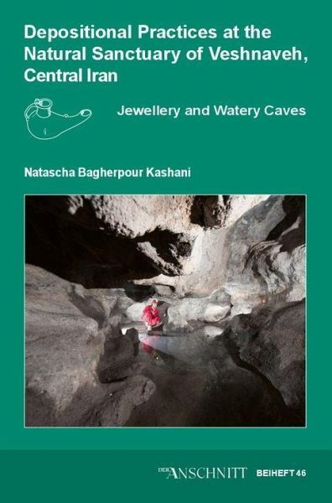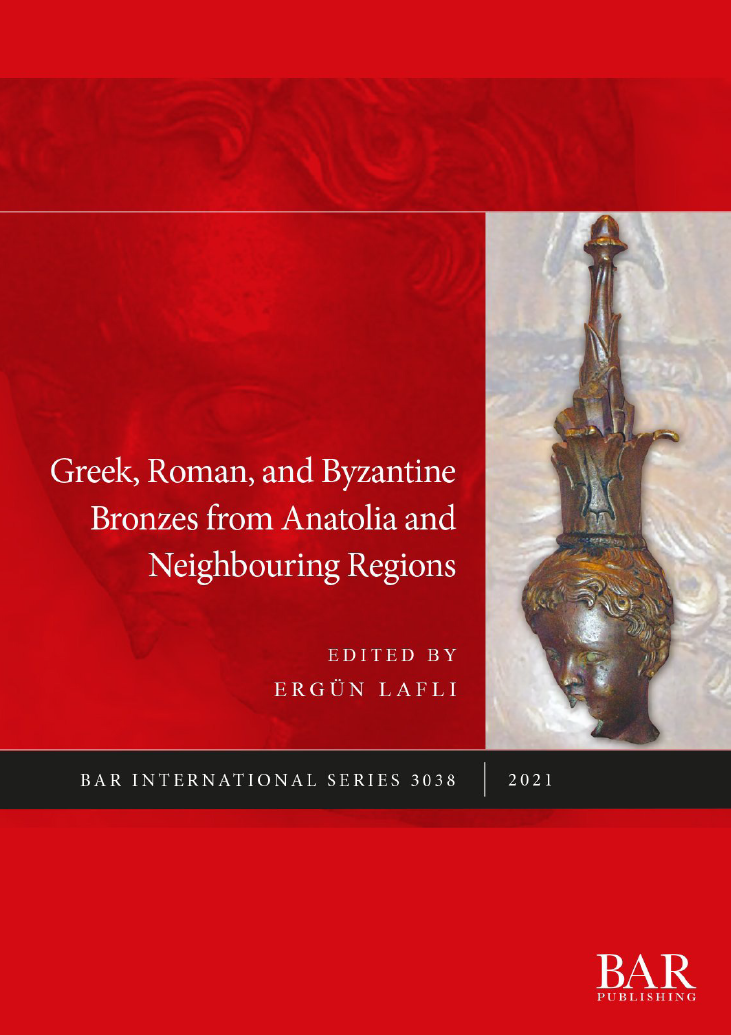Publications so far
0
| 1. |  | Kashani, Natascha Bagherpour: Depositional Practices at the Natural Sanctuary of Veshnaveh, Central Iran: Jewellery and Watery Caves. Verlag Marie Leidorf, Rahden/Westfalen, 2022. (Type: Book | Abstract | Links | BibTeX)@book{nokey,The mining archaeological excavations in Veshnaveh were among the first systematic of their kind in Iran. This is surprising, since the site itself had been known and described since the 1970s, but could not be investigated thoroughly until the early 2000s. The joint Iranian-German research in Veshnaveh was carried out as a part of the “Early Min- ing and Metallurgy in West-Central Iran” project, which had been continued until 2005. In this context, the mining area of Veshnaveh was comprehensively researched and, for the first time, underground excavations and surveys were carried out in the vicinity of the mining area. During our research of the mining evidence, it was the more surprising to discover ritual re-use of a Bronze Age copper mine. The excavations from 2001 onwards made it immediately clear that these deposits were not part of mining debris as one would have expected for mining activities. The findings suggested a different con- text and it was clear that this was a special rural sanc- tuary of pre- and early Zoroastrian cults. |
| 2. |  | Soltani, Anise Nejad; Maziar, Sepideh; Mortazavi, Mohammad: Scientific Investigation On a Copper-Based Pin from Köhn Pāsga Tepesi in the Province of Eastern Azerbaijan (Iran). In: Laflı, Ergün (Ed.): Greek, Roman, and Byzantine Bronzes from Anatolia and Neighbouring Regions, pp. 305-309, BAR Publishing, Oxford, 2021. (Type: Book Chapter | Abstract | Links | BibTeX)@inbook{nokey,In this paper a copper-based pin found in Köhné Pāsgāh Tepesi excavations has been investigated. This archaeological site is located between the villages of Máfrüzlü and Shoja'lu, and is part of the administrative district of Káleybár district, in East Azerbaijan province, Iran. It is located on the south bank of the Araxes valley in the Khodääfarin area. The site is one of several sites that will be submerged by the Khodääfarin dam project.The pin has been thoroughly examined in an attempt to find more about the elements used in the alloys' composition and the manufacturing methods of this object. The analytical methods used include ICP, SEM-EDX and metallography. According to the analytical data, an arsenic-copper alloy has been used to make this object with arsenic content about 3%. The metallographic studies showed banded microstructure evident chemical segregation, but also implied cold working used effectively to manufacture the pin. |
| 3. | Begemann, Friedrich; Haerinck, Ernie; Overlaet, B.; Schmitt-Strecker, Sigrid; Tallon, François: An Archaeo-Metallurgical Study of the Early and Middle Bronze Age in Luristan, Iran. In: Iranica Antiqua, vol. 43, pp. 1-34, 2008. (Type: Journal Article | Abstract | Links | BibTeX)@article{nokey,Copper-base artefacts from Bronze Age Luristan have been analysed for their chemical composition and the isotopic composition of their lead. We find no significant systematic differences between a group of objects recovered in the Pusht-i Kuh region in the course of controlled excavations during the Belgian Archaeological Mission in Iran (BAMI) and a second group of artefacts from the Louvre Museum which were acquired on the art market. According to these material features the objects from the art market are made of genuine "Luristan" metal which does not exclude the possibility that the artefacts are recent forgeries made of "old" metal. The data suggest a large fraction of the artefacts, copper and bronze, to derive from copper ores as they are available in the eastern part of the central Zagros Mountains from where also tin ores have been reported. Bronzes with high 206Pb-normalized abundance ratios, conspicuous in contemporary Mesopotamia, are missing in Luristan. We have no satisfactory explanation to offer why the manifold cultural and material connections between Mesopotamia and Luristan should have excluded the trade in bronzes with such exceptional lead isotopy. | |
| 4. | Pigott, Vincent Charles; Lechtman, Heather: Chalcolithic copper-base metallurgy on the Iranian plateau: a new look at old evidence from Tal-i lblis. In: Potts, Timothy; Roaf, Michael; Stein, Diana (Ed.): Culture through Objects. Ancient Near Eastern Studies in Honour of P.R.S. Moorey
, pp. 291-312, Peeters, 2003, ISBN: 9780900416798. (Type: Book Chapter | Links | BibTeX)@inbook{nokey, | |
| 5. | Hezarkhani, Zahra; Keesmann, Ingo: Archäometallurgische Untersuchungen an Kupferschlacken im Zentraliran. In: Metalla, vol. 3, no. 2, pp. 101-125, 1996. (Type: Journal Article | BibTeX)@article{nokey, | |
| 6. | Caldwell, Joseph R.: Tal-i-Iblis und der Beginn der Kupfer-Metallurgie im 5. Jahrtausend. In: Archaeologia Viva, vol. 1, pp. 145-150, 1968. (Type: Journal Article | BibTeX)@article{nokey, | |
| 7. | Thornton, Christopher P.; Lamberg-Karlovsky, C. C.; Liezers, Martin; Young, Suzanne M. M.: On Pins and Needles: Tracing the Evolution of Copper-base Alloying at Tepe Yahya, Iran, via ICP-MS Analysis of Common-place Items. In: Journal of Archaeological Science, vol. 29, iss. 12, 0000. (Type: Journal Article | Abstract | Links | BibTeX)@article{nokey,From 1967 to 1975 a team of archaeologists excavated the site of Tepe Yahya in southeastern Iran under the direction of C. C. Lamberg-Karlovsky. Although there are two forthcoming “final reports” (Hiebert (in progress), and Magee (in press); see also Lamberg-Karlovsky & Potts, 2001), analysis of the materials continues as opportunities allow. Metal artefacts, most especially those made of copper and its alloys, are found at this site from the late Neolithic through the Iron Age. Archaeometallurgical analysis, radiocarbon chronologies, and archaeological interpretation allow one to state when and how a type of metal or a style of object was invented, its use as a trade item, and its function and value to an ancient community. In the hopes of establishing a framework for future archaeometallurgical studies, most of the metal artefacts from Tepe Yahya, Iran, stored in the Peabody Museum of Harvard University, were analysed for elemental composition to complement stylistic and metallographic data. |
2022 |
|
 | Kashani, Natascha Bagherpour: Depositional Practices at the Natural Sanctuary of Veshnaveh, Central Iran: Jewellery and Watery Caves. Verlag Marie Leidorf, Rahden/Westfalen, 2022. (Type: Book | Abstract | Links | BibTeX | Tags: Bronze Age, Copper, copper base, Metal Resources, Mining, Qom, Religious structures, Resources)@book{nokey,The mining archaeological excavations in Veshnaveh were among the first systematic of their kind in Iran. This is surprising, since the site itself had been known and described since the 1970s, but could not be investigated thoroughly until the early 2000s. The joint Iranian-German research in Veshnaveh was carried out as a part of the “Early Min- ing and Metallurgy in West-Central Iran” project, which had been continued until 2005. In this context, the mining area of Veshnaveh was comprehensively researched and, for the first time, underground excavations and surveys were carried out in the vicinity of the mining area. During our research of the mining evidence, it was the more surprising to discover ritual re-use of a Bronze Age copper mine. The excavations from 2001 onwards made it immediately clear that these deposits were not part of mining debris as one would have expected for mining activities. The findings suggested a different con- text and it was clear that this was a special rural sanc- tuary of pre- and early Zoroastrian cults. |
2021 |
|
 | Soltani, Anise Nejad; Maziar, Sepideh; Mortazavi, Mohammad: Scientific Investigation On a Copper-Based Pin from Köhn Pāsga Tepesi in the Province of Eastern Azerbaijan (Iran). In: Laflı, Ergün (Ed.): Greek, Roman, and Byzantine Bronzes from Anatolia and Neighbouring Regions, pp. 305-309, BAR Publishing, Oxford, 2021. (Type: Book Chapter | Abstract | Links | BibTeX | Tags: Archaeometallurgy, Copper, copper base, East Azerbaijan)@inbook{nokey,In this paper a copper-based pin found in Köhné Pāsgāh Tepesi excavations has been investigated. This archaeological site is located between the villages of Máfrüzlü and Shoja'lu, and is part of the administrative district of Káleybár district, in East Azerbaijan province, Iran. It is located on the south bank of the Araxes valley in the Khodääfarin area. The site is one of several sites that will be submerged by the Khodääfarin dam project.The pin has been thoroughly examined in an attempt to find more about the elements used in the alloys' composition and the manufacturing methods of this object. The analytical methods used include ICP, SEM-EDX and metallography. According to the analytical data, an arsenic-copper alloy has been used to make this object with arsenic content about 3%. The metallographic studies showed banded microstructure evident chemical segregation, but also implied cold working used effectively to manufacture the pin. |
2008 |
|
Begemann, Friedrich; Haerinck, Ernie; Overlaet, B.; Schmitt-Strecker, Sigrid; Tallon, François: An Archaeo-Metallurgical Study of the Early and Middle Bronze Age in Luristan, Iran. In: Iranica Antiqua, vol. 43, pp. 1-34, 2008. (Type: Journal Article | Abstract | Links | BibTeX | Tags: Archaeometallurgy, Bronze, Bronze Age, Copper, copper base)@article{nokey,Copper-base artefacts from Bronze Age Luristan have been analysed for their chemical composition and the isotopic composition of their lead. We find no significant systematic differences between a group of objects recovered in the Pusht-i Kuh region in the course of controlled excavations during the Belgian Archaeological Mission in Iran (BAMI) and a second group of artefacts from the Louvre Museum which were acquired on the art market. According to these material features the objects from the art market are made of genuine "Luristan" metal which does not exclude the possibility that the artefacts are recent forgeries made of "old" metal. The data suggest a large fraction of the artefacts, copper and bronze, to derive from copper ores as they are available in the eastern part of the central Zagros Mountains from where also tin ores have been reported. Bronzes with high 206Pb-normalized abundance ratios, conspicuous in contemporary Mesopotamia, are missing in Luristan. We have no satisfactory explanation to offer why the manifold cultural and material connections between Mesopotamia and Luristan should have excluded the trade in bronzes with such exceptional lead isotopy. | |
2003 |
|
Pigott, Vincent Charles; Lechtman, Heather: Chalcolithic copper-base metallurgy on the Iranian plateau: a new look at old evidence from Tal-i lblis. In: Potts, Timothy; Roaf, Michael; Stein, Diana (Ed.): Culture through Objects. Ancient Near Eastern Studies in Honour of P.R.S. Moorey
, pp. 291-312, Peeters, 2003, ISBN: 9780900416798. (Type: Book Chapter | Links | BibTeX | Tags: Archaeometallurgy, Copper, copper base)@inbook{nokey, | |
1996 |
|
Hezarkhani, Zahra; Keesmann, Ingo: Archäometallurgische Untersuchungen an Kupferschlacken im Zentraliran. In: Metalla, vol. 3, no. 2, pp. 101-125, 1996. (Type: Journal Article | BibTeX | Tags: Archaeometallurgy, Copper, copper base)@article{nokey, | |
1968 |
|
Caldwell, Joseph R.: Tal-i-Iblis und der Beginn der Kupfer-Metallurgie im 5. Jahrtausend. In: Archaeologia Viva, vol. 1, pp. 145-150, 1968. (Type: Journal Article | BibTeX | Tags: Archaeometallurgy, Copper, copper base)@article{nokey, | |
0000 |
|
Thornton, Christopher P.; Lamberg-Karlovsky, C. C.; Liezers, Martin; Young, Suzanne M. M.: On Pins and Needles: Tracing the Evolution of Copper-base Alloying at Tepe Yahya, Iran, via ICP-MS Analysis of Common-place Items. In: Journal of Archaeological Science, vol. 29, iss. 12, 0000. (Type: Journal Article | Abstract | Links | BibTeX | Tags: Archaeometallurgy, Copper, copper base)@article{nokey,From 1967 to 1975 a team of archaeologists excavated the site of Tepe Yahya in southeastern Iran under the direction of C. C. Lamberg-Karlovsky. Although there are two forthcoming “final reports” (Hiebert (in progress), and Magee (in press); see also Lamberg-Karlovsky & Potts, 2001), analysis of the materials continues as opportunities allow. Metal artefacts, most especially those made of copper and its alloys, are found at this site from the late Neolithic through the Iron Age. Archaeometallurgical analysis, radiocarbon chronologies, and archaeological interpretation allow one to state when and how a type of metal or a style of object was invented, its use as a trade item, and its function and value to an ancient community. In the hopes of establishing a framework for future archaeometallurgical studies, most of the metal artefacts from Tepe Yahya, Iran, stored in the Peabody Museum of Harvard University, were analysed for elemental composition to complement stylistic and metallographic data. | |
